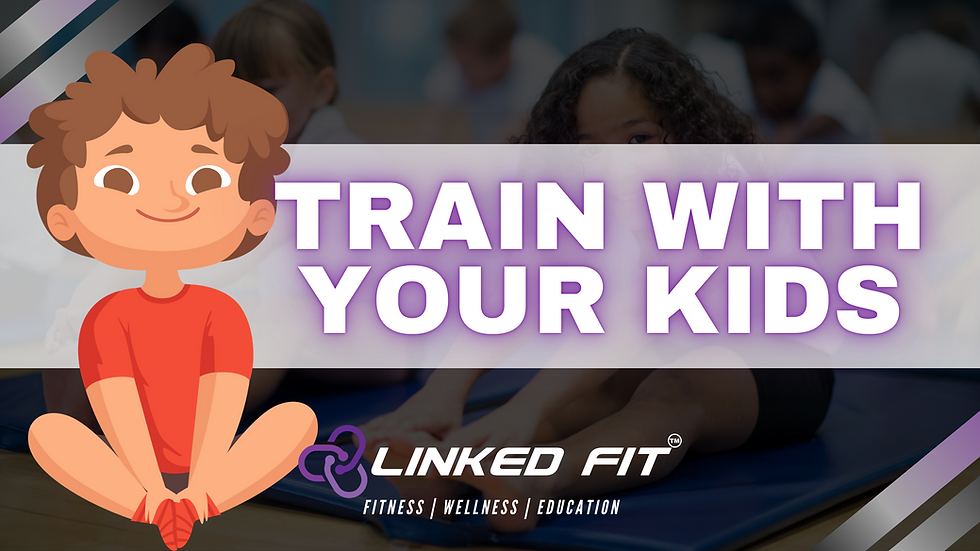Train with your Kids
- Linked Fit

- Jul 20, 2022
- 4 min read

Why should you make your child your training partner? Have you ever considered resistance training with your child? Did you know that updated research has shown that resistance training for children/adolescents is recommended?

You should expose your child to a gym environment, let them see you work out, or have them work out with you!! A child’s brain operates differently than an adult's. A child uses a much larger neurological potential and capacity of their brain. They grow exponentially, taking in massive amounts of input learning how to feel, think, memorize, judge, and give labels to things, themselves, and others. This input develops their neurological networks, becomes ingrained, and creates their experience.
As a child, you mirror your parents/guardians. Essentially, you do what they do.
Exposing your child to the gym early can allow them to see and process resistance training and gyms as being normal and safe. The gym setting and exercise, in general, are still viewed as an intimidating and uncomfortable atmosphere, even for adults. It should be viewed oppositely! Getting children exposed to this type of environment at a young age can begin to build a foundation of an active lifestyle towards resistance training.
Resistance Training for Children/Adolescents
Resistance training offers incredible mental, emotional, and physical benefits for all ages - especially children and adolescents.
2020 WHO physical activity guidelines for children and adolescents (5-17 years old) strongly recommend 3 days a week of intense-vigorous aerobic activity and activities that strengthen muscle and bone (2). Most children and adolescents can achieve their aerobic activity recommendation by participating in sports and playing outside with their friends at school or home. For the activities that strengthen muscle and bone, resistance training is recommended for children and adolescents. Resistance training is a form of exercise that includes movements using free weights, machines, resistance bands, plyometrics, etc (1). Any gym you walk into should have the proper equipment for proper resistance training. Resistance training aims to build muscle, muscular strength, endurance, and power (1).
The benefits of resistance training in children/adolescents have been shown to (1):
increase strength
Build strong bones and reduce the risk of injury
Increase motor unit activation
Strengthening tendons
Increase of self-esteem
The benefits of resistance training in children/adolescents are not just for children/adolescents who play sports. If your child plays an instrument, likes to draw, or is into theater acting, the benefits of resistance training are still applicable to whatever they enjoy doing. Furthermore, now that we know that resistance training benefits children/adolescents, we must take a smart approach to properly training them to reap all the benefits.
Resistance Training for the Parent
Resistance training is just as important for you, the parent/guardian!
In a systematic review and meta-analysis by Saeidifard et al.(2019), resistance training lowered the chance of all-cause mortality by 21% without aerobic exercise (3). Resistance training with aerobic exercise lowered the chance of all-cause mortality by 40% (3). Resistance training can decrease the chance of death by any cause.
This is important data for a parent!!

That last thing a parent would want is to leave their child too soon. You want to be present and to be able to experience the growth of your child/adolescent. To remain active in their life for as long as possible. The same benefits that resistance training has for children/adolescents, apply to adults.
Benefits of Having a Training Partner

When it comes to exercising/training, exploring your child as your training partner can be the missing link that can significantly impact both their development and yours. The premise is more importantly about “strengthening the bond” with someone you share a biological relationship with while simultaneously reaping the benefits of resistance training and training with a partner.
Training with a partner can make training more fun. Having someone with you can allow you to push yourself and introduce you to new movements, encouragement, and support. Being your child's training partner would be the best choice to start their resistance training journey with. As their parent, you already have this built-in trust and connection with your child. If you expose them to a gym and resistance training, they can create a positive correlation between themselves and the gym.
Conclusion
All in all, the premise of this article is to promote training with your child. Take them for their first time if they have never gone. If they currently train, but with their friends or a school team, take the time to enjoy a training session together. Resistance training has been around for a long time and has been proven to be an optimal way to enhance all qualities of life. The research is there now for children/adolescents and resistance training. If you find your child struggling mentally, emotionally, and/or physically, expose them to a gym, to resistance training, the benefits of resistance training, be their training partner, and reinforce that they are stronger than they believe!

References
Myers, A. M., Beam, N. W., & Fakhoury, J. D. (2017). Resistance training for children and adolescents. Translational Pediatrics, 6(3), 137–143.
Chaput, J. P., Willumsen, J., Bull, F., Chou, R., Ekelund, U., Firth, J., Jago, R., Ortega, F. B., & Katzmarzyk, P. T. (2020). 2020 WHO guidelines on physical activity and sedentary behavior for children and adolescents aged 5–17 years: summary of the evidence. International Journal of Behavioral Nutrition and Physical Activity, 17(1).
Saeidifard, F., Medina-Inojosa, J. R., West, C. P., Olson, T. P., Somers, V. K., Bonikowske, A. R., Prokop, L. J., Vinciguerra, M., & Lopez-Jimenez, F. (2019). The association of resistance training with mortality: A systematic review and meta-analysis. European Journal of Preventive Cardiology, 26(15), 1647–1665.



Comments